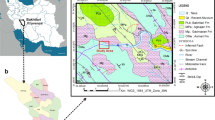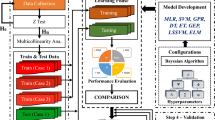Abstract
To predict the behavior of structures in and on jointed rock masses, it is necessary to characterize the geomechanical properties of joints and intact rock. Among geometry properties of joints, trace length has a vital importance, because it affects rock mass strength and controls the stability of the rock structures in jointed rock masses. Since joint length has a range of values, it is useful to have an understanding of the distribution of these values in order to predict how the extreme values may be compared to the values obtained from a small sample. For this purpose, three datasets of joint systems from nine exposures of igneous, metamorphic, and sedimentary rocks are studied. Joint trace length is one of the most difficult properties to measure accurately, but it may be possible to record other geometrical properties of exposed joints accurately; thereby, support vector machine (SVM) model is used to predict the joint trace length. SVM is a novel machine learning method, which is a powerful tool used to solve the problem characterized by small sample and non-linearity with a good generalization performance. Consequently, goodness-of-fit (GOF) tests were applied on these data. According to these GOF tests, the lognormal distribution was found to be the best probability distribution function for representing a joint trace length distribution.





Similar content being viewed by others
References
Aslan B, Zech G (2002) A new class of binning free, multivariate goodness-of-fit tests: the energy tests. In: Conference on advanced statistical techniques in particle physics, Durham, England, 18–22 March 2002
Ayday C (1989) Statistical analysis of discontinuity parameters of Golbasi (Ankara) andesites, Supren (Eskisehir) marble, and Porsuk Dam (Eskis ehir) peridotite. Ph.D. Dissertation, Middle East Technical University, Ankara
Baecher GB (1983) Statistical analysis of rock mass fracturing. Math Geol 15(2):329–348
Baecher GB, Lanney NA (1978) Trace length biases in joint surveys. In: Proceedings of the 19th US Symposium on Rock Mechanics, Nevada, 1–3 May 1978
Baecher GB, Lanney NA, Einstein HH (1977) Statistical description of rock properties and sampling. In: Proceeding of the 18th US Symposium on Rock Mechanics, Colorado, 22–24 June 1977
Barton CM (1978) Analysis of joint traces. In: Proceedings of the 19th Symposium on Rock Mechanics, Nevada, 1–3 May 1978
Barton CA, Zoback MD (1990) Self-similar distribution of macroscopic fractures at depth in crystalline rock in the Cajon Pass Scientific Drill Hole. In: Barton N, Stephansson O (eds) Rock joints. Balkema, Rotterdom, pp 163–170
Bridges MC (1976) Presentation of fracture data for rock mechanics. In: Proceedings of the 2nd Australia–New Zealand Conference on Geomechanics, Brisbane, 21–25 July 1975
Brown ET (ed) (1981) ISRM suggested methods: rock characterization, testing and monitoring. Pergamon, London
Burges CJC (1998) A tutorial on support vector machines for pattern recognition. Data Min Knowl Disc 2(2):121–167
Call RD, Savely JP, Nicholas DE (1976) Estimation of joint set characteristics from surface mapping data. In: Brown WS (ed) Monograph on rock mechanics applications in mining. AIME, Englewood, pp 65–73
Christianini V, Shawe-Taylor J (2002) An introduction to support vector machines. Cambridge University Press, Cambridge
Courant R, Hilbert D (1970a) Methods of mathematical physics, vol 1. Wiley, New York
Courant R, Hilbert D (1970b) Methods of mathematical physics, vol 2. Wiley, New York
Cruden DM (1977) Describing the size of discontinuities. Int J Rock Mech Min 14:133–137
D’Agostino RB, Stephens MA (eds) (1986) Goodness-of-fit techniques. Marcel Dekker, New York
Dershowitz WS, Einstein HH (1988) Characterizing rock joint geometry with joint system models. Rock Mech Rock Eng 21:21–51
Ehlen J (2002) Some effects of weathering on joints in granitic rocks. Catena 49:91–109
Einstein HH, Baecher GB (1983) Probabilistic and statistical methods in engineering geology. Rock Mech Rock Eng 16:39–72
Evans E, Hastings N, Peacock B (1993) Statistical distributions, 2nd edn. Wiley, New York
Gumede H, Stacey TR (2007) Measurement of typical joint characteristics in South African gold mines and the use of these characteristics in the prediction of rock falls. J S Afr I Min Metall 107:335–344
Harr ME (1977) Mechanics of particulate matter—a probabilistic approach. McGraw-Hill, New York
Herget G (1982) Probabilistic slope design for open pit mines. Rock Mech 12:163–178
Hudson JA, Harrison JP (1997) Engineering rock mechanics: an introduction to the principles. Elsevier, Oxford
Hudson JA, Priest SD (1983) Discontinuity frequency in rock masses. Int J Rock Mech Min 20(2):73–89
International Society for Rock Mechanics (1978) Commission on standardization of laboratory and field tests: suggested methods for the quantitative description of discontinuities in rock masses. Int J Rock Mech Min 15:319–368
Kulatilake PHSW, Watugala DN, Stephanson O (1993) Joint network modeling with a validation exercise in Strip mine, Sweden. Int J Rock Mech Min 30:503–526
Kulatilake PHSW, Chen J, Teng J, Shufang X, Pan G (1996) Discontinuity geometry characterization in a tunnel close to the proposed permanent shiplock area of the three gorges dam site in China. Int J Rock Mech Min 33(3):255–277
Kulatilake PHSW, Um J, Wang M, Escandon RF, Narvaiz J (2003) Stochastic fracture geometry modeling in 3-D including validations for a part of Arrowhead East Tunnel, California, USA. Eng Geol 70:131–155
Mehmet S (2009) The stochastic assessment of strength and deformability characteristics for a pyroclastic rock mass. Int J Rock Mech Min 46:613–626
Mercer J (1909) Functions of positive and negative type and heir connection with the theory of integral equations. Phil Trans R Soc A 209:415–446
Meyer T, Einstein HH (2002a) Geologic stochastic modeling and connectivity assessment of fracture systems in the Boston area. Rock Mech Rock Eng 35(1):23–44
Meyer T, Einstein HH (2002b) Geologic stochastic modeling and connectivity assessment of fracture systems in the Boston Area. Rock Mech Rock Eng 35(1):23–44
Muspratt MA (1972) Numerical statistics in engineering geology. Eng Geol 6:67–78
Odling NE, Gillespie P, Bourgine B, Castaing C, Chiles JP, Chrisensen NP, Fillion E, Genter A, Olsen C, Thrance L, Trice R, Aarseth E, Walsh JJ, Watterson J (1999) Variations in fracture system geometry and their implications for fluid flow in fractured hydrocarbon reservoir. Petrol Geosci 5:373–384
Palmstrom A (1995) A rock mass characterization system for rock engineering purposes. Ph.D. Thesis Oslo University, Norway
Park HJ, West TR (2001) Development of a probabilistic approach for rock wedge failure. Eng Geol 59:233–251
Priest SD (1993) Discontinuity analysis for rock engineering. Chapman & Hall, London
Priest SD, Hudson JA (1976) Discontinuity spacing in rock. Int J Rock Mech Min 13:135–148
Priest SD, Hudson JA (1981) Estimation of discontinuity spacing and trace length using scanline surveys. Int J Rock Mech Min 18:183–197
Raja R (2003) A measure of the goodness of fit in unbinned likelihood fits: end of Bayesianism? PhyStat C030908:61–69
Sari M, Karpuz C, Ayday C (2010) Estimating rock mass properties using Monte Carlo simulation: Ankara andesites. Comput Geosci 36:959–969
Song JJ, Lee CI (2006) Estimation of a joint diameter distribution by an implicit scheme and interpolation technique. Int J Rock Mech Min 43:512–519
Terzaghi K (1946) Introduction to tunnel geology. In: Proctor RV, White TL (eds) Rock tunneling with steel supports. Commercial Shearing & Stamping, Youngstown, pp 5–153
van Hameren A (2006) Goodness-of-fit tests in many dimensions. Nucl Instrum Meth A 559:167–171
Vapnik VN (1995) The nature of statistical learning theory. Springer, New York
Vapnik VN (1998) Statistical learning theory. Wiley, New York
Villaescusa E, Brown ET (1992) Maximum likelihood estimation of joint size from trace length measurements. Rock Mech Rock Eng 25:67–87
Wallis RF, King MS (1980) Discontinuity spacings in a crystalline rock. Int J Rock Mech Min 17(1):63–66
Warburton PM (1980) Sterological interpretation of joint trace data: influence of joint shape and implications for geological surveys. Int J Rock Mech Min 17(6):305–316
Weiss M (2008) Techniques for estimating fracture size: a comparison of methods. Int J Rock Mech Min 45:460–466
Author information
Authors and Affiliations
Corresponding author
Rights and permissions
About this article
Cite this article
Zadhesh, J., Jalali, SM.E. & Ramezanzadeh, A. Estimation of joint trace length probability distribution function in igneous, sedimentary, and metamorphic rocks. Arab J Geosci 7, 2353–2361 (2014). https://doi.org/10.1007/s12517-013-0861-1
Received:
Accepted:
Published:
Issue Date:
DOI: https://doi.org/10.1007/s12517-013-0861-1




